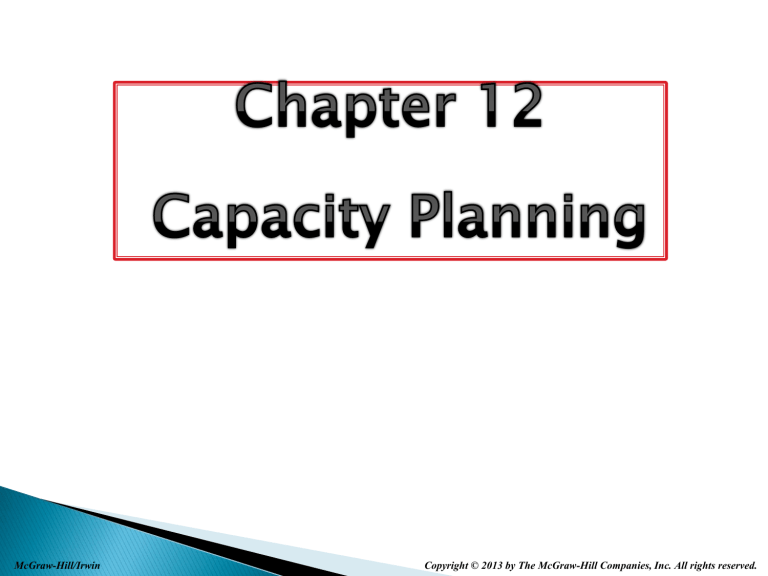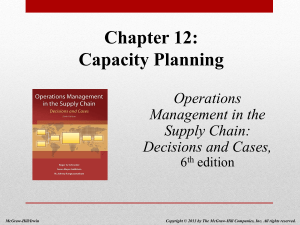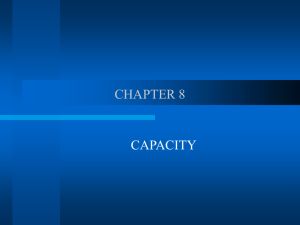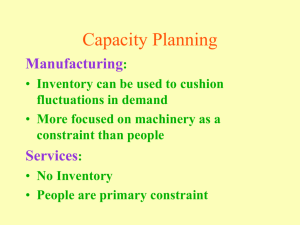
McGraw-Hill/Irwin
Copyright © 2013 by The McGraw-Hill Companies, Inc. All rights reserved.
Facilities
decisions
Facilities
decisions
Aggregate
planning
Aggregate
planning
Scheduling
Scheduling
0
6
12
18
24
Months
Planning Horizon
122
Maximum output that can be produced
over a given period of time.
•
Theoretical capacity
•
Effective capacity
• Labor availability and overtime
• Physical assets, delayed maintenance, etc.
• Can be used for short-term demand spikes
• Should be used in planning
• Subtracts maintenance downtime, shift
breaks, absenteeism, etc.
123
Utilization = Actual output
Capacity
x 100%
Utilization is seldom 100%.
Estimates capacity usage and ‘busyness.’
124
How much capacity is needed?
How large should each facility be?
When is the capacity needed?
Where should the facilities be located?
What type of facilities/capacity are needed?
125
Considers:
• Amount of capacity
• Size of capacity cushion
•
Size of facilities
• Economies/diseconomies of scale
•
Timing of facility decisions
• Preemptive, wait-and-see
•
Types of facilities
• Product-focused, market-focused, process-focused,
general-purpose
126
1.
Predicted demand
2.
Cost of facilities
3.
Likely behavior of competitors
4.
Business strategy
5.
International considerations
127
Capacity cushion = 100% – utilization
Three strategies:
1. Large cushion (e.g., make-to-order)
2. Moderate cushion (cost of running out
balanced with cost of excess capacity)
3. Small cushion (e.g., make-to-stock)
128
1.
Economies of scale
◦ Production costs are not linear
◦ Overhead spread over more units
2.
Diseconomies of scale
◦ Increased transportation costs
◦ Cost of more bureaucracy
◦ Increased organizational complexity
129
1.
Preempt the competition
◦ Build capacity ahead of need
◦ Positive capacity cushion
2.
Wait-and-see strategy
◦ Small or negative capacity cushion
◦ Lower risk strategy
1210
1.
Quantitative Factors
ROI, NPV
Transportation, Taxes
Lead times
2.
Qualitative Factors
Language, norms
Worker and customer attitudes
Proximity to customers, suppliers, competitors
1211
1.
Product-focused (55%)
One family of products/services (e.g., computers)
2.
Market-focused (30%)
Located near sales (e.g., electricity, bakeries)
3.
Process-focused (10%)
Few technologies (e.g., computer chips, MRI center)
4.
General purpose (5%)
Several products/services (e.g., furniture, banking)
1212
•
•
Matching supply & demand over a medium time
range
Time horizon of about 12 months
•
Aggregated demand for one or few categories of
product. Demand may fluctuate or be uncertain.
•
Possible to change both supply and demand
•
Variety of management objectives
•
Facilities are fixed (cannot be expanded or
reduced)
1213
1.
Budgeting: closely tied to aggregate plan
2.
HR: workforce availability
3.
Operations: capacity/inventory planning
4.
Accounting: cost analysis
5.
Finance: capital investments
6.
Marketing: sales plan
1214
1.
Pricing
2.
Advertising and promotion
3.
Backlogs or reservations (shift demand)
4.
Development of complementary offerings
Seasonal products/service spread demand
Lawn mower, snow blower
Ski resort, mountain biking
1215
1.
Share Hiring and layoff of employees
2.
Using overtime and undertime
3.
Using part-time or temporary labor
4.
Carrying inventory
5.
Outsourcing/subcontracting
6.
Cooperative arrangements
• capacity during demand peaks
• Airlines, hotels, utilities
1216
1.
Level strategy
• Constant work force
• Inventory as buffer
2.
Chase strategy
• Vary workforce
• Produce to demand
• Typical for services
1217
Chase Strategy Level Strategy
Level of labor skill required
Job discretion
Compensation rate
Training required per employee
Labor turnover
Hire-layoff cost per employee
Amount of supervision required
Type of budgeting and forecasting required
Low
Low
Low
Low
High
Low
High
Short-run
High
High
High
High
Low
High
Low
Long-run
1218
Hiring and firing costs (Chase strategy)
Overtime and undertime costs (Chase)
Subcontracting costs (Chase)
Part-time labor costs (Chase)
Inventory-carrying costs (Level strategy)
Cost of stockout or back order (Level)
1219
Facilities Decisions
Facilities Strategy
Sales & Operations Planning Definition
Cross-Functional Nature of S&OP
Planning Options
Basic Aggregate Planning Strategies
Aggregate Planning Costs
Aggregate Planning Example
1220






